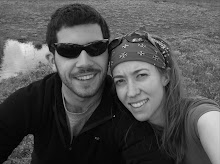Jess and I took Astro for his first swim this weekend. We made our way out to the Canyon on the first clear day after 3 rainy ones. The trees and fields in Somoto are all starting to turn green. Although we are officially entering the “winter” season, this past week has been the closest to the spring we experience in the States. Hopefully you can see how green the mountain south of our house is getting. I decided to post two pictures: The first is the mountain right after a few hours of rain. The next is the same mountain the following afternoon. Pretty beautiful, huh?
So, we made our way to the Canyon, which includes 2 crossings of the Rio Coco (Coconut River). The Rio Coco is the driving force creating the Somoto Canyon. It continues on from here to become the official border between Nicaragua and Honduras for about 450 kilometers and finally drains into the Carribean Sea. The Rio Coco is the spiritual focus of Nicaragua’s indigenous cultures. It’s said to have mystic powers: any one who swims in it leaves the river fluently speaking the native tongue!
 Here´s the Rio Coco after the canyon.
Here´s the Rio Coco after the canyon.On our previous trips to the Canyon the Rio Coco was a quiet meandering stream, still about 50 feet across, but easily crossable with convenient stepping stones. This time, it was a whole other story. Several campesinos (country folk) warned us the river was impassable due to the rains, but we were egged on by the more adventurous cattle drivers. We figured if they could drive a couple mules, 3 cows, and baby calf across the river, we could surely make it with two people and a dog. So, we began.

The water was muddy and the current strong, so every step was careful and slow. We had a couple of false starts, but managed to follow the path taken by a couple fishermen. By the time we were halfway across, we had water up to our stomachs and were taking a half step down stream for every step across. I held Astro out of the water (the current was too strong for the first timer) and Jess carried our backpack with lunch and water.

We made it across the first bend in the river without incident, and the second bend was easier, although a little deeper. Finally, about 45 minutes after leaving the highway, we made it to the boat launch into the canyon. We congratulated ourselves with refried beans and honey rolled in pancakes (delicious) and granola. Despite the roughness down river, the canyon entrance was calm and without much current in the pools along the shore.

To get Astro accustomed to the water (he was a little shook up from the previous episodes) we threw sticks further and further away from shore. Slowly, but surely, he started to come around, and after an hour his initial fears were a thing of the past. Instead of heading further into the canyon like we normally do we decided to just relax at the boat launch for the morning.

Around noonish we made our way back across the river, which seemed just as strong as earlier in the day, and caught a cab to Somoto. It was a good days workout for everyone, and we’re pretty sure Astro hasn’t gotten that much exercise in a single day during his whole 5 month life.
Earlier that weekend we made our way to Ocotal, a local department capital, to do some banking as well as explore the town. We found a beautiful grocery store that boasted foods we have seen since the States. I know a grocery store doesn’t sound that exciting, but we spend a good hour there. First of all, they were giving away free samples. You can’t pass that up. Then we found peanut butter, a very rare thing in Nicaragua. Jess and I bought 2 jars and that constituted one of our biggest expenses this month: 155 córdobas, or about $8.00. We also came across real chocolate milk. We didn’t even make it out of the store before finishing off the carton. This place also had an incredible variety of soups, which come dried in a bag, not in a can. We didn’t buy any, but made plenty of mental notes about future meals we can prepare. All and all a very successful trip!








 Anyway, we had a few hours to explore before the vaccination was done. We saw some beautiful views, that’s for sure. It was a little sad that Astro couldn’t come, but we had no idea what it would be like so we erred on the side of caution. Don’t worry, though. He’ll be getting up there as soon as we have a free Saturday.
Anyway, we had a few hours to explore before the vaccination was done. We saw some beautiful views, that’s for sure. It was a little sad that Astro couldn’t come, but we had no idea what it would be like so we erred on the side of caution. Don’t worry, though. He’ll be getting up there as soon as we have a free Saturday.






